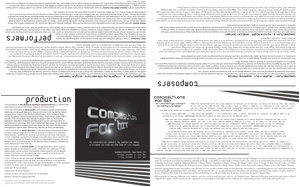Description
Compositions for Bit is an interactive art concert that paid tribute to Disney's 1982 movie Tron and its handmade vision of the digital; the performance took place on the day before the sequel, Tron Legacy, came out in theaters.
Presented at Judson Church in New York, the performance was designed as an immersive experience. As though stepping into the game grid in Tron, the audience was bathed in projections and enveloped in quadrophonic sound.
Dancers wearing Wiimotes performed inside sculptures of Bit, a floating polyhedron from the 1982 movie, who is the first CGI movie character. The Wiimotes were reprogrammed to allow the dancers' movements to control original sound scores. Performing choreography inspired by yogic contortions, the dancers navigated the close confines of their shapes to flip and roll the Bits around the room. They were visible through windows in the shapes and via wireless video feeds. The videos, displayed on large geometric screens that hung above the space, were mixed live during the performance, blending the dancers' real time feeds with Tron's stark landscapes, bobbing Bits, and video game footage from the Tron arcade game. The audience was invited to move freely around the space and interact with the dancers.
Statement
Tron is an inspiration for my art, which imagines the interior life of machines. The movie does much the same thing. Created on the cusp of the computer age, Tron literally takes us inside a computer. The landscapes we find there are clean and cold, dark and geometric, glowing and neon, gridded and crystalline, alien and logical, mathematical and strange. Like many in my generation, I inherited this image of digital machines' inner workings from Tron.
Yet when we watch Tron today, it looks quaint and handmade; it feels surprisingly warm, illogical, and above all, physical. As Tron is about to be superseded by its sequel, Compositions for Bit pays tribute to these qualities of the original movie.
Tron looks and feels handmade because, in part, it is. The movie was created using a combination of analog animation techniques and some of the earliest computer generated imagery. Bit, who is the first computer generated character in a movie, is an example of the latter. One way Tron negotiated the looming computer age, anxieties about cold war and technocratic threats to human individuality, and the impending assimilation of humans and machines, was by inserting human characters into a digital environment. Compositions for Bit inverts this, remaking Tron's computer generated Bit by hand, and bringing this digital character into our human realm.
The boundaries between humans and machines are also investigated by composers Silvia Ruzanka, Suzanne Thorpe, and Shelley Burgon in their scores. Over the course of the evening, these three "Compositions for Bit," and the choreography that drives them, progress from human-like to increasingly machine-like. Inside three enlarged geometric Bits, human dancers perform the compositions live. The Bit dancers wear video game controllers that have been reprogrammed, allowing them to alter and control the sound compositions through their physical movements.
Tron emits a powerful techno-nostalgic aura because its vision of the computer age was created before the computer age itself. Tron is the product of a culture on the verge. Bit hovers in a third state between yes and no, and the movie spans across analog and digital production. To remember Tron is to remember a moment of media transition. Technology is always changing, so just as Tron employed cutting edge technology in its day, Tron Legacy will take advantage of the newest special effects. The release of Tron Legacy closes the book on this iconic part of cultural history and Compositions for Bit marks the occasion, by remembering the original film and by appreciating those qualities in Tron that progress will erase.



















